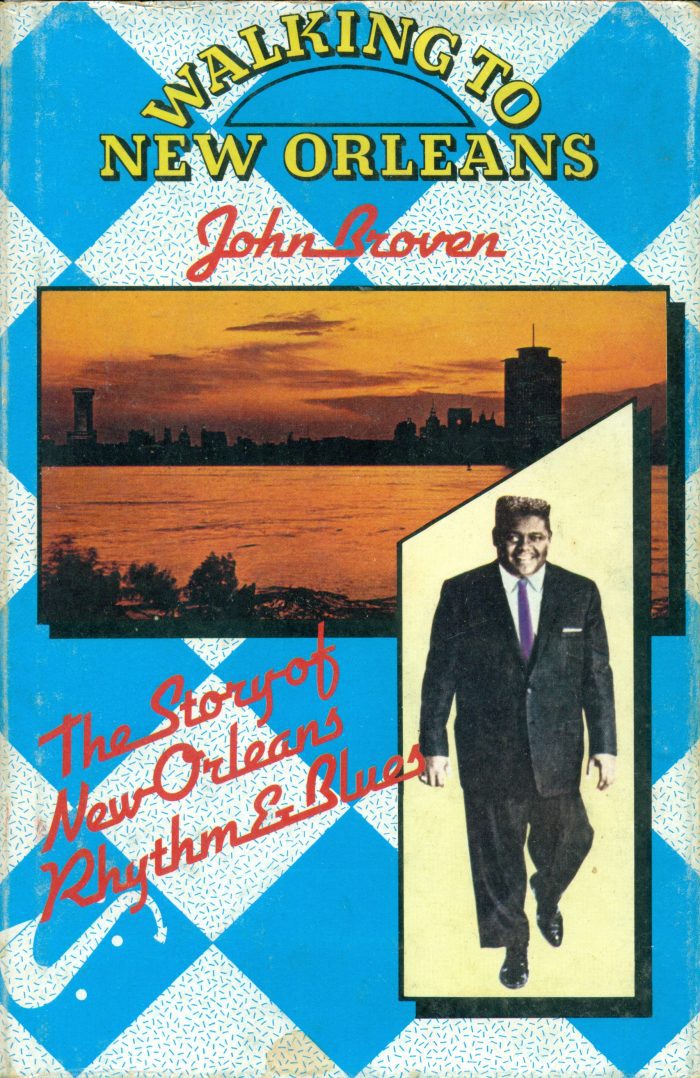By John Broven
My first book, “Walking to New Orleans: The Story of New Orleans Rhythm and Blues,” was published Aug. 9, 1974. That’s 50 long years ago. The anniversary has triggered memories of my original research, the book’s impact and my subsequent journey from England to live in the United States.
The title was inspired by Fats Domino’s big 1960 hit — although his most famous record was “Blueberry Hill.”
An Englishman walking to New Orleans? It had a nice surreal ring.
Importantly, I discovered early on there was an untold story ready to be documented, namely the rise and fall of New Orleans R&B in the rock ‘n’ roll era (1945-70). The city’s vibrant R&B scene was a successor to its proud jazz heritage. My coverage extended beyond the artists, to include record people, session men, disc jockeys, distributors, jukebox operators, clubs and the musicians’ union, to give a rounded picture of the local music industry.
With the passing of time, very few of the original interviewees are still alive, which makes the preservation of their stories even more satisfying. The interview tapes and associated files are now lodged with my record collection, at the Library of Congress.
I had made my magical debut journey to the United States in April 1970, when transatlantic travel was an expensive luxury. Mike Leadbitter, my mentor and co-founder of Blues Unlimited — the first international blues magazine — and Robin Gosden, of Flyright Records, completed our small party.
We started out in New Orleans, then traveled through south Louisiana, up to Shreveport, Louisiana, across to Jackson, Mississippi, and then north, to Memphis, Chicago and New York. All locations had strong blues, (and more,) connections, as we observed the cultural and social conditions, firsthand. It was the time of good old-fashioned, shoe-leather journalism, when pen and notebook ruled.
Writing the book
On our return home, Leadbitter inquired pointedly if I was going to write a book. After asking on what subject, he retorted, “You’ve just been to New Orleans, haven’t you?”
The fuse had been lit.
And so, in the early 1970s I began assembling material for a first draft while, still, working full time in bank management. With the notable exception of Charlie Gillett’s seminal, “The Sound of the City,” there were few books covering any genre of rock ’n’ roll at the time.
The big breakthrough came in 1972, when Leadbitter arranged an interview in London for us with Dr. John, then making waves as the “Night Tripper” of voodoo rock.
The good doctor proved to be a walking encyclopedia of New Orleans R&B, much preferring to shed light on forgotten artists and musicians, as well as discussing hallowed sessions at Cosimo Matassa’s recording studios, than promote his own career.
With the first draft completed, I made another trip to New Orleans, for further interviews, to consolidate my initial research. It was spring 1973, just when the Nixon Watergate scandal was brewing.
In the introduction to the first edition, I recorded my excitement at approaching New Orleans by plane and thinking, “Could it be down there, that Fats Domino, Professor Longhair, Huey Smith, Allen Toussaint, Earl King, Ernie K-Doe, Lee Dorsey and a whole host of talented musicians, made their names and actually live?”
Pre-Hurricane Katrina, most original, New Orleans R&B performers were still living in town so it was relatively easy to track them down — aided by my New Orleans friend and driver, James La Rocca, of course. The interviewees willingly told their rich stories into what was a, comparatively, new invention — a tape recorder.
Publication
On my return, I set about transcribing the interviews, and incorporating the best bits into the existing draft.
Simon Napier, the other co-founder of Blues Unlimited, suggested that the magazine should publish “Walking to New Orleans.”
We ordered an optimistic 3,000 copies, including 500 hardbacks, from the magazine’s professional printer. Our marketing strategy — if it could be described as such — was that Blues Unlimited had just over 2,000 subscribers, who were so interested in Black music, that half of them would buy the book to cover the outlay.
Amazingly, it worked.

We sold a thousand copies by November 1974 and easily recouped our investment. That was the month Mike Leadbitter, such a visionary blues researcher, died of meningitis, at the tragically young age of 32.
The book’s reviews were universally favorable, (almost).
For promotion, I was a guest on two BBC radio shows, including “Honky Tonk,” hosted by Charlie Gillett, on Aug. 4, 1974. I nervously asked Gillett what his first question was going to be, to which he replied, “I don’t know, whatever comes to my head.” Luckily, the New Orleans records we played spoke for themselves.
A year or so later, out of the blue, Milburn Calhoun, owner of Pelican Publishing Co., in Gretna, Louisiana, asked if he could license the book for the U.S. We knew he would be able to hit markets that we ourselves could not possibly touch, such as the New Orleans tourist shops, and the Louisiana educational system.
But Calhoun insisted that the title be changed in spite of the self-explanatory subtitle — to my regret.
He said that “Americans” would not understand the title, “Walking to New Orleans.” And so the book became the simplistic “Rhythm and Blues in New Orleans” (1978.) In the pre-internet era, it wasn’t a problem, but over time, there was modest confusion about the same book having different titles.
The great thing is that Pelican has kept the book in print until now. Its reception was good enough for Pelican to commission another book, “South to Louisiana: The Music of the Cajun Bayous” (1983,) detailing the local Cajun, zydeco, swamp blues, hillbilly and swamp pop music scenes.
In 2016, Pelican published an updated third edition of “Rhythm and Blues in New Orleans,” and followed with an updated “South to Louisiana,” which won a 2020 ARSC award for “Best History in Recorded Country, Folk, or Roots Music.”
Oh, and yes. “Walking to New Orleans” was inducted into the Blues Hall of Fame in 2011, as a Classic of Blues Literature. The various editions of the book have sold in excess of 25,000 copies.
The book’s legacy
It is hard for me to be objective about the legacy of “Walking to New Orleans.” What I can say is that by documenting and preserving stories, it brought a spotlight on many overlooked artists and musicians. Quite a few enjoyed resurrected careers. With the record reissue market in its infancy, the book helped to open up a back catalog of New Orleans R&B recordings on LP, and then, compact disc.
Remember, this was decades before music was just click away on Apple, Spotify, YouTube and the like.
I was delighted when local researchers Tad Jones, Jeff Hannusch and Rick Coleman, took up the challenge to explore the New Orleans R&B scene, in even greater depth, with their later books.
Further support in the city came from Wavelength, and then Offbeat magazines, not to mention Radio WWOZ, the Jazz & Heritage Festival and the Ponderosa Stomp.
“Walking to New Orleans” and “South to Louisiana” led me to write many liner notes for record companies — first for LPs, then for CDs. The books served as calling cards that led to my commission as a compilation consultant for Ace Records in London, from 1991 to 2006.
This experience paved the way for writing “Record Makers and Breakers: Voices of the Independent Rock ’n’ Roll Pioneers,” (University of Illinois Press, 2009), where I interviewed influential record men and women, who launched the indie record business in the post-World War II years. Again, almost all the interviewees are dead, but oh what stories they had to tell.
Over the years, I have spoken at conferences from New Orleans to Los Angeles, and even the Rock and Roll Hall of Fame.
The cherry on the cake was meeting my wife, Shelley, through the Ace Records connection — her father owned Golden Crest Records, out of Huntington Station — and starting a new life on Long Island.
I was living the English Dream and American Dream at the same time. What a journey it has been — and to think, it all started 50 years ago!
John Broven of East Setauket is a copyeditor with TBR News Media. In celebration of the book’s 50th anniversary, Jasmine Records in the U.K. has released a double CD “Walking to New Orleans: An Aural Accompaniment” (available on Amazon).





